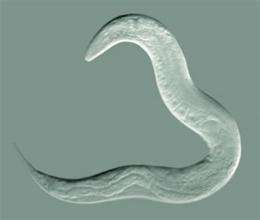Pinhead-size worms + robot = new antibiotics

In an advance that could help ease the antibiotic drought, scientists in Massachusetts are describing successful use of a test that enlists pinhead-sized worms in efforts to discover badly needed new antibiotics. Their study appeared in ACS Chemical Biology, a monthly journal.
Frederick Ausubel and colleagues note in the new study that existing methods for identifying germ-fighting drugs involve adding the potential drug to cultures of bacteria or cells and watching the results. These tests sometimes do not work well. They may give passing grades to potential drugs that are toxic, or that fight bacteria in the same ways as existing antibiotics that are loosing effectiveness against drug-resistant bacteria.
A much better test would involve screening of potential new antibiotics in living animals infected with bacteria to see the effects on the entire body of the animal.
The scientists describe successful use of such a whole-animal high throughput screening test — automated with a robot — to test the effects of 37,000 potential drugs on C. elegans (a type of worm) infected with E. faecalis (a type of bacteria). That bacterium causes life-threatening infections in humans. C. elegans are tiny nematode worms that are widely used in scientific research. The tests identified 28 potential new drugs never before reported to have germ-fighting effects. Some of the potential new drugs worked in ways that appeared to be totally different than existing antibiotics.
More information: "High-Throughput Screen for Novel Antimicrobials using a Whole Animal Infection Model" ACS Chemical Biology
Source: American Chemical Society (news : web)
















